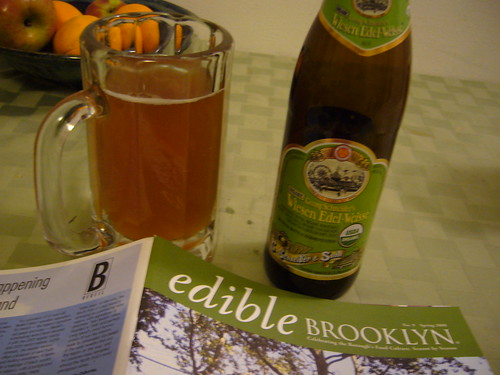
Last Saturday was my much anticipated locavore potluck. I had been awaiting the day since I first thought up the idea sometime over winter - to bring together my friends for the most noblest of potlucks, encouraging them to seek out local food sources.
I'll have it in March, I planned, naively expecting that by then the bounty of spring would appear in the farmers markets. And when March continued in winter's fashion, I hoped April would bring fresh vegetables. Until April also did not seem flush enough with green. I almost had a date set in May, once asparagus and lettuce appeared, but scheduling conflicts pushed it back another month.
Then of course nature pulled a trick and jolted into summer with a heat wave, thick and oppressive and blowing hot air and sweat around our bodies. But the show must go on, so I planned to get most of the cooking done in the morning with the hopes that the apartment would cool off before the party. The morning found me at Union Square (bizarrely with larger crowds at 9am than I'd ever seen on a Saturday) to pick up a pork roast from
Flying Pigs. Stupidly I hadn't asked for it to be defrosted when I ordered it, so it was frozen solid. Luckily after an hour an and a half in a water bath at home, it seemed mostly defrosted, so into the crockpot along with a sliced onion, barbeque sauce, salt, pepper, and a little water. This is my usual method for making
pulled pork, and it couldn't be easier. You just leave it in there for hours and hours on low in the crock pot, maybe turn it up to high for a couple hours, and then back to low, and after about 8-10 hours it shreds when you go to cut it.
While the pork defrosted, I got to work on buns for the pulled pork. I thought the heat would help these babies rise into fluffy buns even more beautifully than
last time, but instead they refused to rise and ended up as tight undercooked mini buns. I have no idea what happened, but they sufficed for the purpose. And the mini buns meant that people piled less pulled pork onto their sandwiches, leaving me with more leftovers (muhaha!)
While the oven preheated for the buns, I also
roasted some potatoes into fries. Now common sense would dictate that you would not be silly like me and turn your oven on and instead buy hamburger buns and make something like a cold potato salad. But I was determined to use my local flour for the buns. And Jesse insisted on having roasted potatoes since he doesn't like potato salad, and since we had an overflow of potatoes from
last week's party, I had to do something with them. So all my sweating in a sauna of a kitchen was my own fault.
I also picked up
garlic scapes, which are young garlic shoots, at the market that morning. They are often transformed into garlic scape pestos, but I thought they would be perfect in aioli for dipping the fries. Aioli is essentially garlic mayonnaise, and I found it to be easier to make than I expected. I noticed, though, that I didn't seem to need as much olive oil as the recipe called for, probably because my eggs were on the smaller side. So I recommend slowly whisking in the oil and stopping when the mixture has reached the right consistency, even if you have some oil left over. Mine was creamy and thinner than commercial mayonnaise, but with a much brighter, richer flavor. Now that I know how easy it is, I'll definitely be making my own mayonnaise again, except this time I'll store some in the fridge right away so I can enjoy it later in the week - instead of leaving it all out in my 90 degree living room for more than three hours during the party and then tossing the leftovers from fear.
Although I finished cooking by 2pm, the apartment wasn't any cooler by partytime, but everyone seemed to have a good time despite the heat. Now, the party wasn't entirely local - the invitation just asked that everyone try to bring something incorporating at least one local ingredient. Eating locally is new to most of my friends, so I wanted it to be an encouraging, not daunting, challenge. I was impressed that my guests all made an effort to bring something local, and enjoyed trying all their great food. There was nary a bag of chips or can of PBR to be found.
My sister (who is working at
Bobolink for the summer since it's only a 5 minute drive from our parent's home - how cool is that?) brought rosemary bread she'd baked that morning, and one of Bobolink's new spring cheeses, Tarte de Vache (Cow Pie), which was medium soft, grassy and pungent. Two vegetarian couples coincidentally both brought tortellini salad, and another standout was a jar of curry-pickled baby turnips and radishes. There was also a brilliant strawberry rhubarb bruschetta with fresh mint. As well as my pulled pork sandwiches, fries, and heavenly aioli, all local except for the yeast, barbecue sauce, salt, pepper, lemon juice, and vinegar.
For dessert there was a chocolate chip loaf from a Greenmarket bakery, ice cream from
Ronnybrook and
5 Boroughs (warning: their Cha Cha Chocolate is super spicy), strawberries, and locally made marshmallows from Whole Foods. And of course, a few bottles of New York state wine, and lots and lots of Brooklyn, Bluepoint, and Southampton beer. The party didn't end until late in the night when all the booze ran out and I was ready to slip into a food and drink-induced coma.
 Garlic Scape Aioli
Garlic Scape Aioli2 stalks garlic scapes
1 tbsp fresh parsley
salt
pepper
1 egg yolk
1 tsp lemon juice
1 tsp vinegar
1/2 cup extra virgin olive oil
Combine garlic scapes, parsley, salt, and pepper in a food processor. Alternately, you can mince them finely, or use a mortar and pestle, but my mortar and pestle doesn't seem to do much so I went the mechanic route.
Scrape garlic mixture into a bowl and whisk in egg and then lemon juice and vinegar.
With one hand, pour olive oil very slowly into the bowl, while whisking briskly and continually with the other hand. (Not as hard as it sounds.) If you add too much oil at once, just pause your pouring and whisk until it is incorporated. Taste occasionally, and once the mixture has reached your desired consistency and taste, stop adding oil.
Store immediately in an airtight container in the refrigerator for up to five days. Serve with fries, fish, asparagus, or spread on sandwiches.















 The burgers were grass finished black angus from a new Greenmarket vendor,
The burgers were grass finished black angus from a new Greenmarket vendor,  It rained just as we woke in the morning, so we stayed inside the tent until the torrents passed. Unfortunately that meant we didn't have time to cook breakfast before we had to pack up and check out, so breakfast was at Roscoe Diner.
It rained just as we woke in the morning, so we stayed inside the tent until the torrents passed. Unfortunately that meant we didn't have time to cook breakfast before we had to pack up and check out, so breakfast was at Roscoe Diner. 

 While there, we also stopped at
While there, we also stopped at 





























